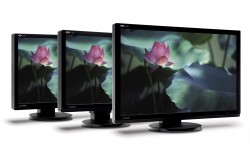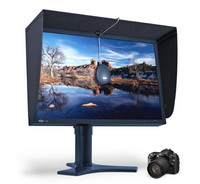
There are three major factors that a photographer or fine art reproducer should consider when selecting a monitor: Color gamut, bit depth and calibration ability. There are other things to consider as well, such as viewing angle, contrast range, refresh rate (if doing video work), and others, depending on your business model.
Color Gamut: The rule of thumb when it comes to color gamut is that bigger is better. You can find this information by checking the spec sheet of the monitor. It should provide you with percentage of sRGB, Adobe 1998, or NTSC (similar to Adobe 1998).
If you are a photographer whose workflow only exists in sRGB, then a monitor that hits 100% of this color gamut is the best. If you primarily work in Adobe 1998, then a monitor that displays 100% of this color space is recommended. If you are using ProPhoto as your color space, then the largest color gamut technology allows is your best option.
Bit Depth: The more bit depth a monitor has, the more accurate it will render your 16-bit files. A 10-bit monitor is the bare minimum with today’s technology, with 12 being a better option. Higher bit depth improves smoothness in transitions and gradients, whereas a lower bit depth might make them appear banded. You can also find this information in the spec sheet of a monitor.
Calibration Ability: It is imperative that you can adjust three parts of a monitor’s appearance. The first of these is brightness. You should be able to adjust how bright a monitor is according to the ambient light of your studio. 120 candelas per meter squared is a good LCD starting point. The second of these is contrast. This helps the monitor achieve a desired gamma setting. Today’s standard is Gamma 2.2, and I recommend this setting. The final calibration is white point. You must be able to adjust the individual red, green, and blue channels to create custom white points. A preset white point of 6500K may, in fact, be 6300K or 6800k. You cannot trust these preset options because they many not be accurate to begin with, and may shift over time.
A great monitor choice is LaCie’s 700 series. It uses a technology called RGB-LED – Backlit. Because it is RGB-LED, it can achieve significantly larger color gamuts than any other monitor available. The 724 (24 in.) and 730 (30 in.) can achieve 123% of Adobe 1998. Also, the bit depth is now 14 bit. This is the best option for the Adobe 1998 and ProPhoto color space user.
If you are interested in getting a new monitor, please feel free to contact a LexJet account specialist at 800-453-9538 and we can figure out the best solution for your needs.

